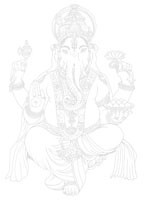Yoga In Our Age: Yoga Sutra of Patanjali

The word Yoga now invites images of soccer moms rushing to the local fitness center to catch a class in 'Power Yoga' in designer yoga clothes, on a designer yoga mat, with a celebrity yoga teacher. Every year, the number of Americans celebrating the power and effect of yoga grows (15 million accoring to Yoga Journal in 1994). Alas, poor Patanjali, writer of the Yoga sutras in the 3rd century CE would not recognize his yoga nor would he credit these active stretchers as yogis.
' This is teaching of Yoga.
Yoga is the cessation of the turning of thought.
When thought ceases, the spirit stands in its true identity as observer to the world.
Otherwise, the observer identifies with the turnings of thought...
Cessation of the turning of thought comes through practice and dispassion.
Practice is the effort to maintain the cessation of thought.'
-Yoga Sutra of Patanjali
Yoga is the cessation of the turning of thought.
When thought ceases, the spirit stands in its true identity as observer to the world.
Otherwise, the observer identifies with the turnings of thought...
Cessation of the turning of thought comes through practice and dispassion.
Practice is the effort to maintain the cessation of thought.'
-Yoga Sutra of Patanjali
Based within the philosophical system of Samkhya, the Yoga of Patanjali (to which little is known) emphasizes separating the connection from the phenomenon world, bringing an end to cittavrttis (turning of thought). Suffering (duhkha) is brought about by the connection between observer (purusa) with the observed (prakrti). Isolation from this connection, or kaivalya, leads to moksa, which is the yogic term for liberation.
The Astanga Yoga, or "Eight-limbed" Yoga of Patanjali leads the practitioners through eight successive stages, ending in liberation. The pervading conscious self must be separated from unconscious matter.
The Eighfold Path
- 1) Yama - Moral Principles
- nonviolence
- truthfulness
- abjuration of stealing
- celibacy
- absence of greed
2) Niyama- Observances
Most of these are outside of the experience of the West. They include: Bodily purification, contentment [no more listening to, "Oh Lord won't you buy me a Mercedes Benz"], ascetic practice, study of sacred lore, and dedication to Lord of Yoga (not Baron Baptiste)
3) Asana- Postures
Asana are not mindless stretching exercises. We can say that we are adapting "Yoga to the West" but when we take the mind out of the practice, we take the yoga out as well. A local Miami paper printed an ad for a stitching/sewing company with a line: "It's yoga for the mind." There is little wonder that most will gravitate towards their bodies in the practice of yoga, especially in the west, where the colorful media convince us that self-oriented attachment, making ourselves a showcase for others desire, is the highest virtue. We must always remember the goal of yoga is to separate the conscious self from the unconscious matter, not engage ourselves in the mirror and admire our contours or admonish our faults. We should choose not to play this foolish game.
4) Pranayama- breath control
Pranayama and asana go hand in hand and the above apply here.
5) Pratyahara- Withdrawal of the senses
When our senses come in contact with an object, there is a response. If we desire further contact with that object, the internal neural and chemical process grows stronger. In time, this process is like the well worn tracks of the donkey cart that have etched into the mud for miles and this track must be used with little choice. The only real hope is to withdrawal the senses and stop this neural and chemical response from occurring, rebuild the system, and when the system is ready, it can return to the world without as much risk of harm or attachment.
6) Dharana - Concentration
Thought is narrowed to a single-point.
7) Dyhana - Meditation
Here the idea is the focus the mind onto one wave of thought, unifying mind and body, and preventing all outside and other inside influences from providing distraction.
8) Samadhi - Pure Contemplation
At the highest level we realize that we cannot use thought to realize thought, for another thought is needed. Pure awareness must be used at this stage. When pure awareness is realized, moksa can be gained.
"Since thought is an object of perception, it cannot illuminate itself.
Nor can both thought and its objects be comprehended simultaneously.
If a thought is the object of another thought, there is an infinite regression from intelligence to intelligence, and a confusion of memory.
Awareness of its own intelligence occurs when thought assumes the form of the spirit through consciousness that leaves no trace...
One who sees the distinction between the lucid quality of nature and the observer ceases the cultivate a personal reality."
Nor can both thought and its objects be comprehended simultaneously.
If a thought is the object of another thought, there is an infinite regression from intelligence to intelligence, and a confusion of memory.
Awareness of its own intelligence occurs when thought assumes the form of the spirit through consciousness that leaves no trace...
One who sees the distinction between the lucid quality of nature and the observer ceases the cultivate a personal reality."
In the end, the world will be what it is of our own choosing. It can be discouraging to see how far off the path Western Yoga has fallen. However, we may learn the asana in our local yoga class, all the while adhering to all eight limbs of Patanjali's yoga. When we press our hands onto the mat there must be an attempt to unify breath and body. At the later stages we seek to separate the observer from the observed. There will not be a time when the true or false nature of another path will enter our minds, and if it does, we will let it go. The path is inward until there is no path to be found.
In the Miami area, I am aware of a studio in which all of the instructors must study the Yoga Sutra of Patanjali, a Sanskrit scholar is on staff, and the classes are said to be of the highest quality. I have never been to one of these classes nor do I have any affiliation with the studio but will provide a link due to the relevance to the above post.
----------------------
Heeds, Peter Indian Religions: A Historical Reader of Spiritual Expression and Experience New York: New York University Press, 2002Religion,Yoga,Mind,Consciousness

Religion,Yoga,Mind,Consciousness



















3 Comments:
Who knows where to download XRumer 5.0 Palladium?
Help, please. All recommend this program to effectively advertise on the Internet, this is the best program!
Very enjoyable post. I like it. Looking for more. Thanks.
Admirable post. Wants more. Thanks.
Post a Comment
<< Home